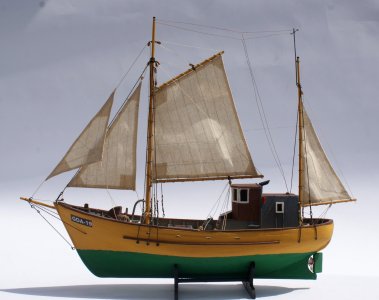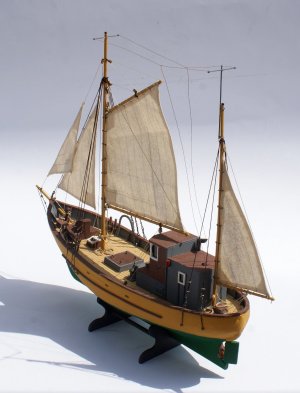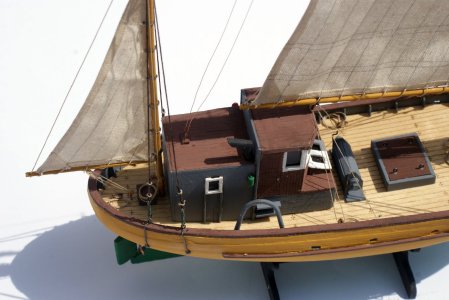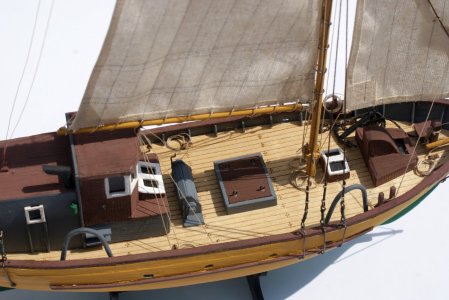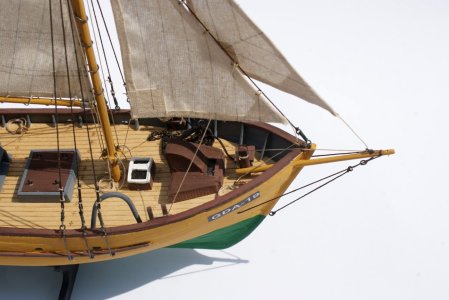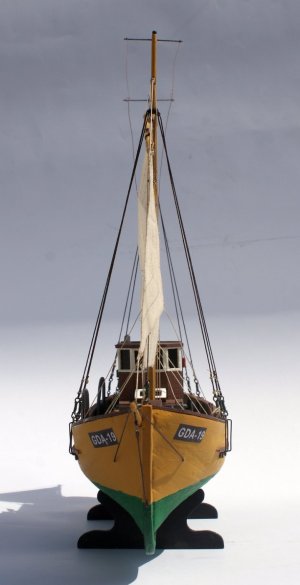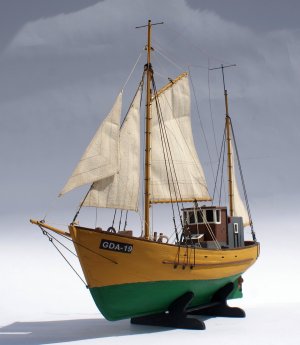After several weeks of rearranging the finished models, I started with a Polish fishing boat or Kuter Rybacki, it is simple, but in the middle of the last century, it was a common fishing vessel in the Baltic.
1 History
The topic is taken from the magazine Modelarz, May 1985, written by Cezary Ciesielski. The quotation marks are a free translation of the article. We will discuss a Kuter (cutter) Rybacki (fishing boat in Polish), which was a mixed-construction vessel of steel and wood from the post-war period.
“The beginnings of fishing vessel construction in Poland date back to the interwar period, when the first such unit was established in Gdynia in 1922 at Franciszek Ledke's shipbuilding workshop. The Sea Fisheries Institute, founded in 1928, inspired the workshop's creation. The Institute supported the activity of the Gdynia shipbuilder by ordering several cutters, which were then resold on credit to Polish fishermen. During this time, documentation for an optimal unit was developed, assigning it the symbol "MIR-20."
After World War II, the reconstruction of destroyed cities and the creation of a new maritime economy began. The modernized "MIR-20A" cutters were the first seagoing units built in Poland after the war. They were built in 1946 at the Northern Shipyard in Gdańsk and the Goynia Shipyard. The need to build cutters of mixed construction (frames of Steel, oak planks, emerged from the difficult conditions.
A cutter of this construction type was built as a somewhat experimental unit in 1949 at the Gdansk North Sea Shipyard. Initially, it was operated by Gdansk Fishermen as the "GDA-19." Later, the unit was rebuilt and modernized, successively serving fishermen in Świr, Jastrzębie, and Darłowo. The vessel was converted into a diving cutter (1051), changed to Swi-79 (1966), Dar-27 (1969), and was deregistered in 1997”.
2. References:
“Kuter Rybacki z 1949 r. GDA-19” Cezary Ciesielski, Modelarz Magazine 1985/05
“Profiling of small-scale fishing communities in the Baltic Sea” Delaney, Alyne.

 pl.wikipedia.org
pl.wikipedia.org
 www.naszbaltyk.com
www.naszbaltyk.com
 www.naszbaltyk.com
www.naszbaltyk.com
3. General Information
KUTER RYBACKI GDA-19
Country: Gdansk, Poland
Type: Kuter
Function: Fishing
Length: 17.70 m (295 mm)
Beam: 5.04 m (84 mm)
Depth 3.45 m (57 mm)
Total Length 20.75 m (345 mm)
Total Height 15.90 m (265 mm)
Scale 1:60
By Jose Ruesta - Lima, Peru
4. Model Preparation
I took the idea and information from the 1985/05 Modelarz magazine. From there, I obtained the frame box and longitudinal profile, and drew the frames and false keel using AutoCAD. I measured the other dimensions, such as the diameter and length of the mast and yard, sail dimensions, lashing position, planking size, hold entrance dimensions, and other deck elements, directly (using AutoCAD) from the photos or engravings of that article. I cut the frames and false keel, aligned them, and glued them with white glue. Then, using a knife and sandpaper, I shaped them to improve the fit of the strakes in the frames. I prepared the 2x5 mm cedar strakes for the entire hull up to the bow. The hull and the inside of the bow were brushed and sanded (100-grit sandpaper). After being satisfied that there were no noticeable ridges, a coat of acrylic resin was applied, allowing it to dry thoroughly for 24 hours, after which it was sanded again (320-grit sandpaper). A light coat of filler was applied over the imperfections, and a white base coat was painted. The exact dimensions and shape of the deck were evaluated so that it would fit over the frames and fit snugly against the inside of the hull. The waterline was defined with a laser, and from there, the hull was painted green, and the inside of the bow was painted gray. The topsides were painted ochre yellow, as were all the rigging. There were two decks: one blank, to which the planks would have to be laid one by one, and the other laser-printed, so I opted for the latter.
The bowsprit (painted yellow), the 1x4 mm gunwale cover in brown, and the jibs, of varying heights, were installed in gray. The chain stays for the shrouds were made of 0.7 mm wire with eyelets at both ends, the lower end nailed to the hull. The rudder was also prepared, and the propeller was made from tin and painted bronze.
Also using AutoCAD, the dimensions of other smaller elements were taken and redrawn freehand on a workbook. The various deck and rigging elements were sanded and painted with acrylic.
Work was done on the hold entrance, the wheelhouse, the cabin, the masts (main, mizzen, boom, and gaff), and other parts of the deck, which were painted gray and brown, except for the masts, which were all yellow. All the elements were laid out, aligned, and measured, then glued with white glue. The winch, the anchor with its chain, and the bitts were also installed.
The sails are made of an ecru cotton fabric, somewhat heavier than I would have liked. They were cut to the measurements obtained from the plan, adding 4 millimeters to form a fold for a reinforcing thread and gaffing with white glue. The assembly of the rigging began. In this case, I prepared the entire rigging on the table. After the sail was secured to the boom, gaff, and mast, I mounted it on the model, using white glue and taking great care to ensure verticality and alignment.
Two types of rope were used: 0.35 mm for the halyards and 0.5 mm diameter ecru threads for the remainder. Dark-colored 0.8 mm threads were used for the shrouds. Finally, the radio antenna cables, shrouds, and curved metal elements on the starboard side were attached.
You can find other completed models on my blog:
https://Modelismo Naval: Mi colección (modelismonavaljoseruesta.blogspot.com)
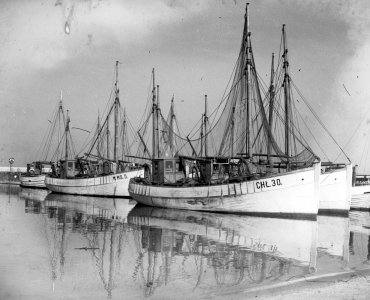
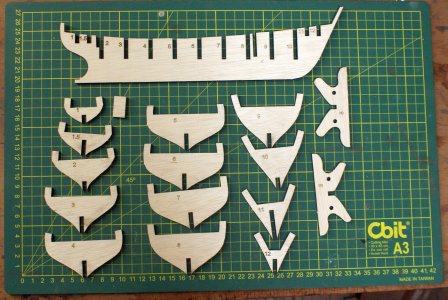
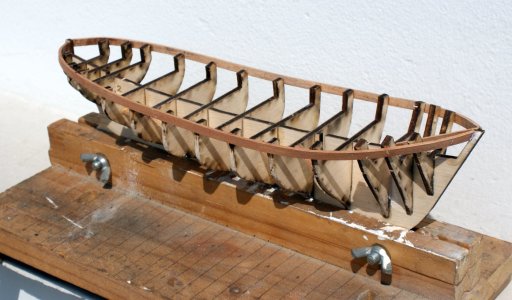
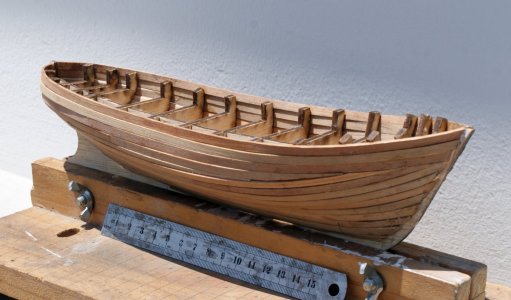
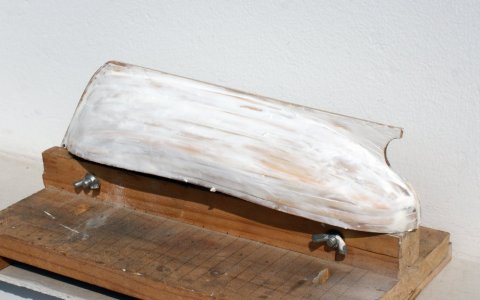
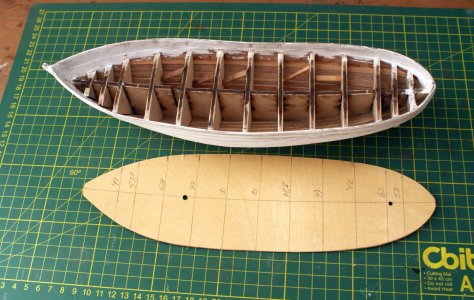
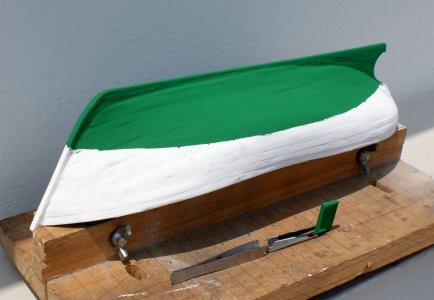
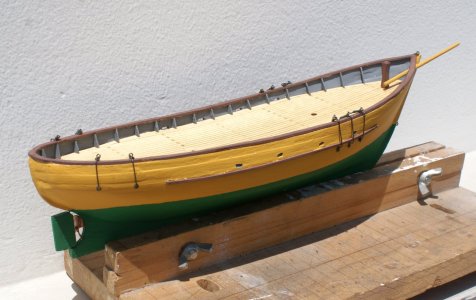
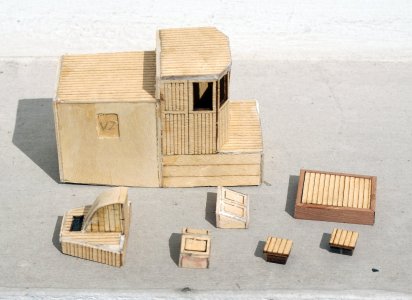
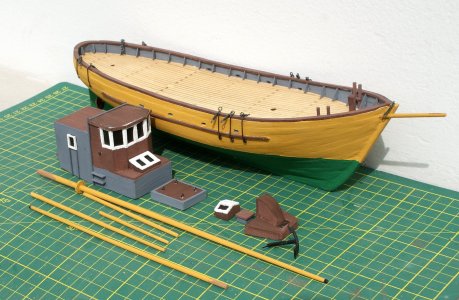
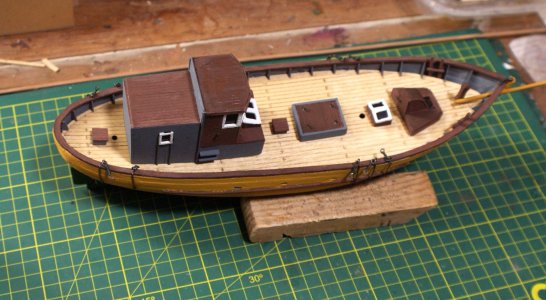
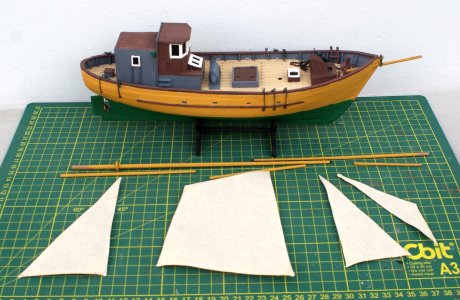
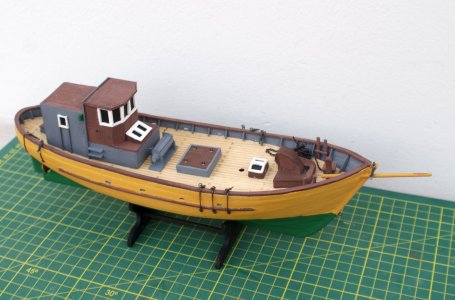
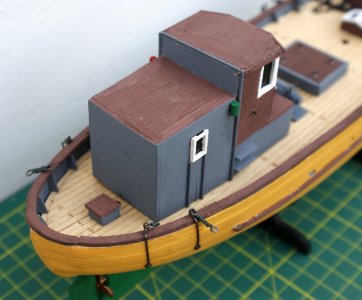
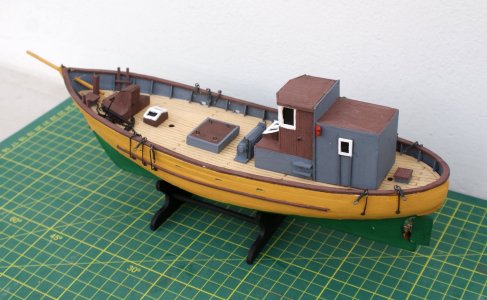
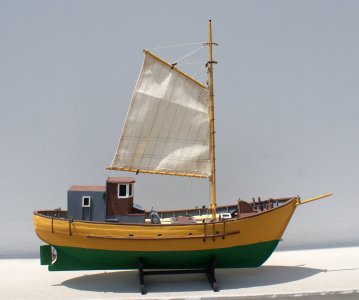
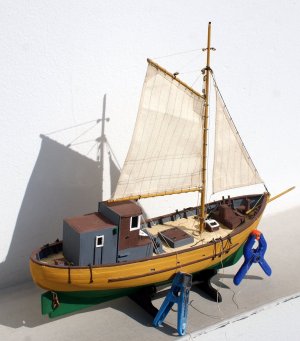
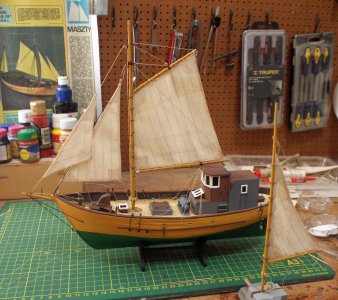
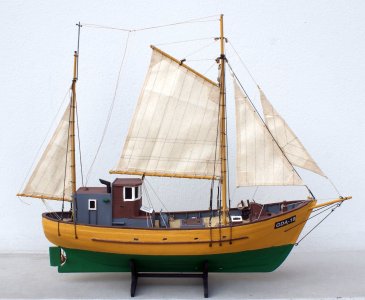
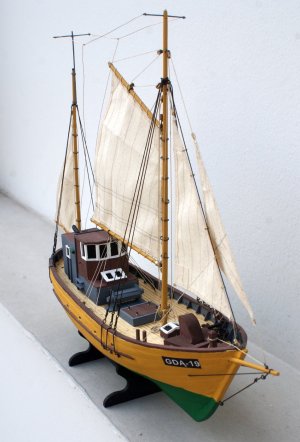
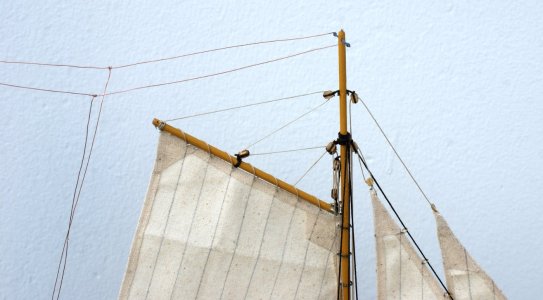
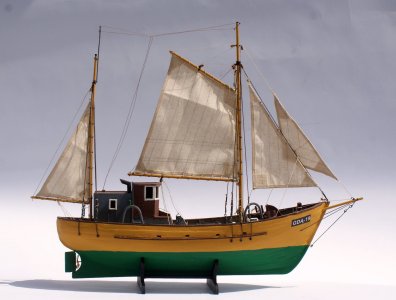
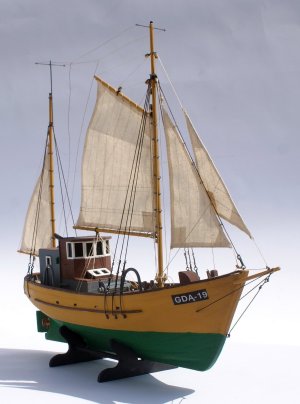
1 History
The topic is taken from the magazine Modelarz, May 1985, written by Cezary Ciesielski. The quotation marks are a free translation of the article. We will discuss a Kuter (cutter) Rybacki (fishing boat in Polish), which was a mixed-construction vessel of steel and wood from the post-war period.
“The beginnings of fishing vessel construction in Poland date back to the interwar period, when the first such unit was established in Gdynia in 1922 at Franciszek Ledke's shipbuilding workshop. The Sea Fisheries Institute, founded in 1928, inspired the workshop's creation. The Institute supported the activity of the Gdynia shipbuilder by ordering several cutters, which were then resold on credit to Polish fishermen. During this time, documentation for an optimal unit was developed, assigning it the symbol "MIR-20."
After World War II, the reconstruction of destroyed cities and the creation of a new maritime economy began. The modernized "MIR-20A" cutters were the first seagoing units built in Poland after the war. They were built in 1946 at the Northern Shipyard in Gdańsk and the Goynia Shipyard. The need to build cutters of mixed construction (frames of Steel, oak planks, emerged from the difficult conditions.
A cutter of this construction type was built as a somewhat experimental unit in 1949 at the Gdansk North Sea Shipyard. Initially, it was operated by Gdansk Fishermen as the "GDA-19." Later, the unit was rebuilt and modernized, successively serving fishermen in Świr, Jastrzębie, and Darłowo. The vessel was converted into a diving cutter (1051), changed to Swi-79 (1966), Dar-27 (1969), and was deregistered in 1997”.
2. References:
“Kuter Rybacki z 1949 r. GDA-19” Cezary Ciesielski, Modelarz Magazine 1985/05
“Profiling of small-scale fishing communities in the Baltic Sea” Delaney, Alyne.
Kuter rybacki – Wikipedia, wolna encyklopedia
WYKAZ POLSKICH KUTRÓW (1) – typ MIR-20 - Nasz Bałtyk - morskie czasopismo
Nasz Bałtyk to czasopismo popularnonaukowe, którego celem jest rozbudzanie, krzewienie i popularyzacja szeroko rozumianej idei Polski na Morzu.
WYKAZ POLSKICH KUTRÓW (3) – kutry typu B-368 - Nasz Bałtyk - morskie czasopismo
Nasz Bałtyk to czasopismo popularnonaukowe, którego celem jest rozbudzanie, krzewienie i popularyzacja szeroko rozumianej idei Polski na Morzu.
3. General Information
KUTER RYBACKI GDA-19
Country: Gdansk, Poland
Type: Kuter
Function: Fishing
Length: 17.70 m (295 mm)
Beam: 5.04 m (84 mm)
Depth 3.45 m (57 mm)
Total Length 20.75 m (345 mm)
Total Height 15.90 m (265 mm)
Scale 1:60
By Jose Ruesta - Lima, Peru
4. Model Preparation
I took the idea and information from the 1985/05 Modelarz magazine. From there, I obtained the frame box and longitudinal profile, and drew the frames and false keel using AutoCAD. I measured the other dimensions, such as the diameter and length of the mast and yard, sail dimensions, lashing position, planking size, hold entrance dimensions, and other deck elements, directly (using AutoCAD) from the photos or engravings of that article. I cut the frames and false keel, aligned them, and glued them with white glue. Then, using a knife and sandpaper, I shaped them to improve the fit of the strakes in the frames. I prepared the 2x5 mm cedar strakes for the entire hull up to the bow. The hull and the inside of the bow were brushed and sanded (100-grit sandpaper). After being satisfied that there were no noticeable ridges, a coat of acrylic resin was applied, allowing it to dry thoroughly for 24 hours, after which it was sanded again (320-grit sandpaper). A light coat of filler was applied over the imperfections, and a white base coat was painted. The exact dimensions and shape of the deck were evaluated so that it would fit over the frames and fit snugly against the inside of the hull. The waterline was defined with a laser, and from there, the hull was painted green, and the inside of the bow was painted gray. The topsides were painted ochre yellow, as were all the rigging. There were two decks: one blank, to which the planks would have to be laid one by one, and the other laser-printed, so I opted for the latter.
The bowsprit (painted yellow), the 1x4 mm gunwale cover in brown, and the jibs, of varying heights, were installed in gray. The chain stays for the shrouds were made of 0.7 mm wire with eyelets at both ends, the lower end nailed to the hull. The rudder was also prepared, and the propeller was made from tin and painted bronze.
Also using AutoCAD, the dimensions of other smaller elements were taken and redrawn freehand on a workbook. The various deck and rigging elements were sanded and painted with acrylic.
Work was done on the hold entrance, the wheelhouse, the cabin, the masts (main, mizzen, boom, and gaff), and other parts of the deck, which were painted gray and brown, except for the masts, which were all yellow. All the elements were laid out, aligned, and measured, then glued with white glue. The winch, the anchor with its chain, and the bitts were also installed.
The sails are made of an ecru cotton fabric, somewhat heavier than I would have liked. They were cut to the measurements obtained from the plan, adding 4 millimeters to form a fold for a reinforcing thread and gaffing with white glue. The assembly of the rigging began. In this case, I prepared the entire rigging on the table. After the sail was secured to the boom, gaff, and mast, I mounted it on the model, using white glue and taking great care to ensure verticality and alignment.
Two types of rope were used: 0.35 mm for the halyards and 0.5 mm diameter ecru threads for the remainder. Dark-colored 0.8 mm threads were used for the shrouds. Finally, the radio antenna cables, shrouds, and curved metal elements on the starboard side were attached.
You can find other completed models on my blog:
https://Modelismo Naval: Mi colección (modelismonavaljoseruesta.blogspot.com)

























